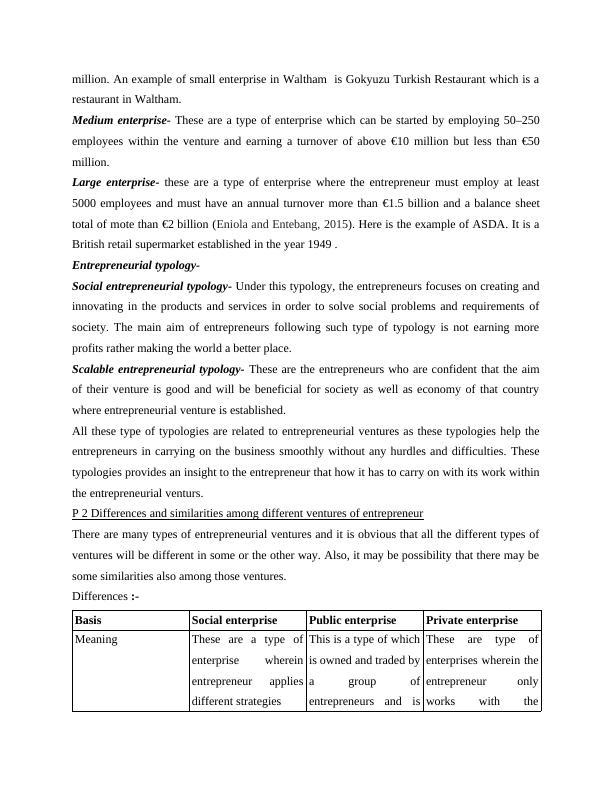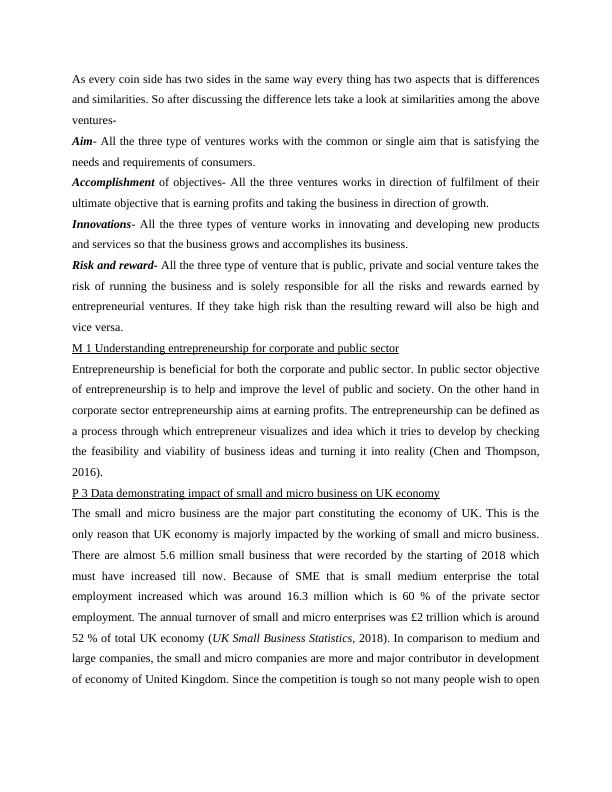Entrepreneurship and Small Business Management in Public and Corporate Sector
Added on 2021-02-20
29 Pages4714 Words63 Views
ENTREPRENEURSHIPAND SMALL BUSINESSMANAGEMENT

Table of ContentsINTRODUCTION...........................................................................................................................3TASK 1............................................................................................................................................3P 1 Types of ventures for entrepreneur and relation with entrepreneurial typology..............3P 2 Differences and similarities among different ventures of entrepreneur...........................4M 1 Understanding entrepreneurship for corporate and public sector...................................6P 3 Data demonstrating impact of small and micro business on UK economy.....................6P 4 Importance of business start-ups and small business in growth of social economy........7M 2 Difference of small, medium and large business............................................................8TASK 2 (covered in PPT)................................................................................................................8CONCLUSION..............................................................................................................................28

INTRODUCTIONEntrepreneurship refers to as a process through which an entrepreneur starts its own businesswherein all the risk is borne by entrepreneur himself. Nowadays entrepreneurship is boomingand is very productive for the economy as well. The present study is based on London Boroughof Waltham Forest Council. This borough is formed on 1 April 1965.The report will start by describing different types ventures and typology of entrepreneur. Furtherreport will highlight similarities and differences among different types of entrepreneurialventures (Kuckertz and Prochotta, 2018). Next with help of data it will highlight the impact ofsmall and micro business on economy along with the importance of start-ups and small businessfor social economy. Furthermore, the report is going to discuss various characteristics and traitsof successful entrepreneurs. Next it will show that how entrepreneurial personality reflects themotivation and mindset of entrepreneur. At last, it will describe the fact that background andexperience of entrepreneur either fosters or hinders the entrepreneurship.TASK 1P 1 Types of ventures for entrepreneur and relation with entrepreneurial typologyAn entrepreneur is someone who wishes to open or start its own business venture orentrepreneurial venture by taking all the risk by himself and all profits as well. He is a personwho visualizes an idea and by checking its viability converts it into a successful business. Thereare many types of different ventures which an entrepreneur can start.On the other hand, intrapreneurship is a system wherein the principle of entrepreneurship isfollowed in business. The only difference between an entrepreneur and an intraprenuer is thatentrepreneur is owner of venture but on the other hand intraprenuer is not the owner but just anemployee of company.Different types of ventures-Micro enterprise- It is a type of venture within which the entrepreneur has to employ minimumof 10 employees within its venture and has a turnover of less than €2 million (What is SME.2019). Example of micro enterprise is Quick Stop which is a local corner store (Harrison andLeitch, eds., 2018).Small enterprise- This is a type of entrepreneurial venture which entrepreneur can start byemploying 10–50 employees and whose annual turnover is above €2 million and less than €10

million. An example of small enterprise in Waltham is Gokyuzu Turkish Restaurant which is arestaurant in Waltham.Medium enterprise- These are a type of enterprise which can be started by employing 50–250employees within the venture and earning a turnover of above €10 million but less than €50million.Large enterprise- these are a type of enterprise where the entrepreneur must employ at least5000 employees and must have an annual turnover more than €1.5 billion and a balance sheettotal of mote than €2 billion (Eniola and Entebang, 2015). Here is the example of ASDA. It is aBritish retail supermarket established in the year 1949 .Entrepreneurial typology-Social entrepreneurial typology- Under this typology, the entrepreneurs focuses on creating andinnovating in the products and services in order to solve social problems and requirements ofsociety. The main aim of entrepreneurs following such type of typology is not earning moreprofits rather making the world a better place.Scalable entrepreneurial typology- These are the entrepreneurs who are confident that the aimof their venture is good and will be beneficial for society as well as economy of that countrywhere entrepreneurial venture is established.All these type of typologies are related to entrepreneurial ventures as these typologies help theentrepreneurs in carrying on the business smoothly without any hurdles and difficulties. Thesetypologies provides an insight to the entrepreneur that how it has to carry on with its work withinthe entrepreneurial venturs.P 2 Differences and similarities among different ventures of entrepreneurThere are many types of entrepreneurial ventures and it is obvious that all the different types ofventures will be different in some or the other way. Also, it may be possibility that there may besome similarities also among those ventures.Differences :-BasisSocial enterprisePublic enterprisePrivate enterpriseMeaningThese are a type ofenterprise whereinentrepreneur appliesdifferent strategiesThis is a type of whichis owned and traded bya group ofentrepreneurs and isThese are type ofenterprises wherein theentrepreneur onlyworks with the

focused on publicwelfare (Terjesen,Hessels and Li, 2016).intention of earningprofits.SizesThese are generallysmall.The minimum numberrequired in publiccompany is 7 and nomaximum limit isthere..Here minimumrequirement is of 2 andmaximum is 200.ControlIt is owned by anycharitable institutesand party to provideservices.It is under control ofgovernment whether itis central, state andlocal.It is owned by privateindividual orcompanies as privatesector.Stability of jobIn this sector notavailable.In this sector jobstability is available.In this sector jobstability is notavailable.PurposeIt purposes is care topoor people.It main purpose isserve services topublic and citizens ofthe country.The major purpose isearning profit is verymajor and to employmore people.ObjectivesThe objective of socialenterprise is to helpthe society indeveloping andgrowing.The objective ofpublic enterprise is tohelp society but at thesame time earn a littleprofit.The only objective ofprivate company is toearn profit.ExamplesIt includes non-profitorganization.It includes police,army, health,manufacturing andeducation areas.It includes Finance,information,technology, mining,transport, education,banking areas.Similarities

As every coin side has two sides in the same way every thing has two aspects that is differencesand similarities. So after discussing the difference lets take a look at similarities among the aboveventures-Aim- All the three type of ventures works with the common or single aim that is satisfying theneeds and requirements of consumers.Accomplishment of objectives- All the three ventures works in direction of fulfilment of theirultimate objective that is earning profits and taking the business in direction of growth.Innovations- All the three types of venture works in innovating and developing new productsand services so that the business grows and accomplishes its business.Risk and reward- All the three type of venture that is public, private and social venture takes therisk of running the business and is solely responsible for all the risks and rewards earned byentrepreneurial ventures. If they take high risk than the resulting reward will also be high andvice versa.M 1 Understanding entrepreneurship for corporate and public sectorEntrepreneurship is beneficial for both the corporate and public sector. In public sector objectiveof entrepreneurship is to help and improve the level of public and society. On the other hand incorporate sector entrepreneurship aims at earning profits. The entrepreneurship can be defined asa process through which entrepreneur visualizes and idea which it tries to develop by checkingthe feasibility and viability of business ideas and turning it into reality (Chen and Thompson,2016).P 3 Data demonstrating impact of small and micro business on UK economyThe small and micro business are the major part constituting the economy of UK. This is theonly reason that UK economy is majorly impacted by the working of small and micro business.There are almost 5.6 million small business that were recorded by the starting of 2018 whichmust have increased till now. Because of SME that is small medium enterprise the totalemployment increased which was around 16.3 million which is 60 % of the private sectoremployment. The annual turnover of small and micro enterprises was £2 trillion which is around52 % of total UK economy (UK Small Business Statistics, 2018). In comparison to medium andlarge companies, the small and micro companies are more and major contributor in developmentof economy of United Kingdom. Since the competition is tough so not many people wish to open

End of preview
Want to access all the pages? Upload your documents or become a member.
Related Documents
Characteristics of Successful Entrepreneurslg...
|16
|4145
|485
Entrepreneurship and Small Business Managementlg...
|15
|4284
|58
P5. Characteristics traits and skill of successful entrepreneurlg...
|13
|3501
|34
Entrepreneurship and Small Business Assignment (Doc)lg...
|16
|4444
|242
Small Business Management and Entrepreneurshiplg...
|20
|5838
|474
Entrepreneurship and Small Business Management- Typeslg...
|11
|2780
|419